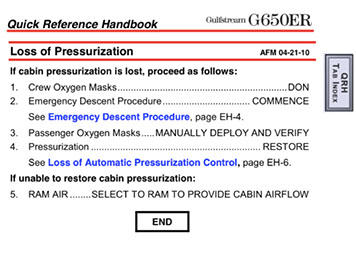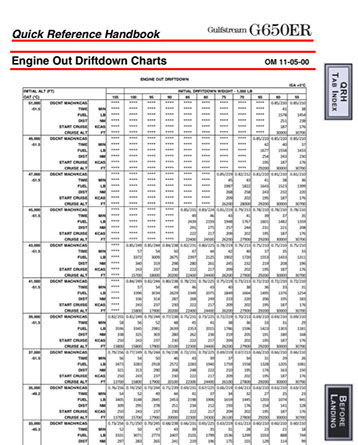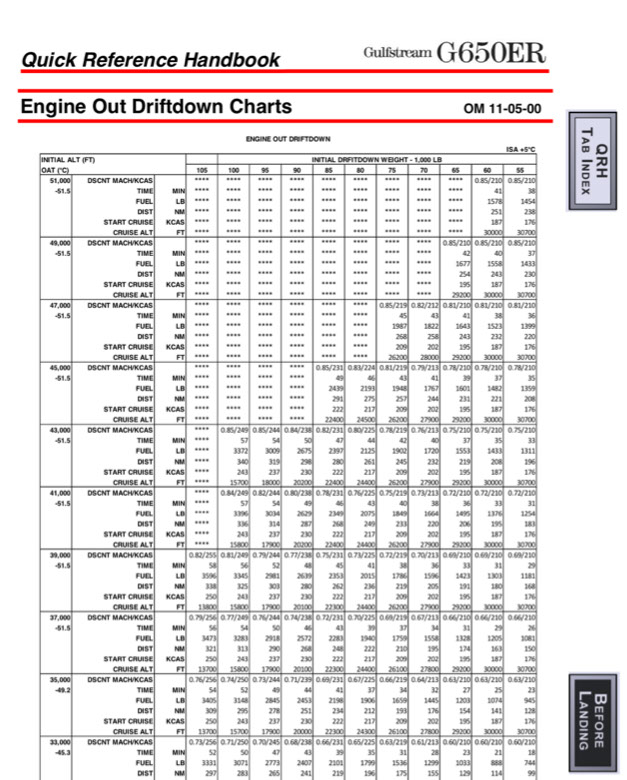A Complete Manual for Conducting International Flight Operations
Oceanic Emergency Duties & Responsibilities
Oceanic Emergency Duties & Responsibilities
Loss of Pressurization
Engine Failure
Medical Emergency
Duties & Responsibilities
The loss of pressurization requires the execution of an emergency descent and is generally considered the most significant failure that occur while in oceanic flight.
If the aircraft is operating in an area such as the NAT HLA where opposing traffic is not separated by a significant distance the following should apply:
- The flight shall attempt to leave the assigned route or track by initially turning at least 45 degrees to the right or left in order to acquire the track offset of 15NM. The direction of the turn shall be determined by the distance to the nearest alternate airport, deviation away from tracks, weather at the alternate and diversionary airports and SLOP.
- Power levers shall be reduced to idle, speedbrakes extended, increase rate of descent until VMO or MMO is reached and use VMO or MMO until reaching desired altitude.

- Deploy passenger oxygen masks and instruct passengers to don masks.
- If in radar environment, divert to the nearest suitable aerodrome, broadcast MAYDAY-MAYDAY or PAN-PAN and intentions on 121.5 and the current ATC frequency, use maximum illumination of aircraft lighting consistent with limitations, squawk 7700, verify local state contingency procedures and complete relevant checklists.
- If it is necessary to reverse track it is not advisable to do so until below the majority of traffic. The majority of traffic is generally considered to be located between FL280-FL410. Once below FL280, execute the turn back maneuver.
If the engine failure occurs after oceanic entry, the flight shall leave the assigned route or track by initially turning at least 45 degrees to the right or left. The direction of the turn shall be determined by the distance to the nearest alternate airport, deviation away from tracks, weather at alternate and diversionary airports and SLOP.
If ABLE to maintain the assigned flight level
The pilot shall maintain current altitude until after deviating 10 NM from the cleared track and thence establish the aircraft at a flight level which differs from standard by 500 feet if below FL410, or 1000 feet if above FL410, i.e. FL405 or FL 440. The flight crew shall alert nearby aircraft on frequency 121.5, 123.45 and the current HF frequency using MAYDAY-MAYDAY or PAN-PAN and advise intentions on 121.5 and the current HF frequency, the flight crew shall use maximum illumination of aircraft lighting consistent with limitations, squawk 7700, verify local state contingency procedures and complete relevant checklists.
For aircraft UNABLE to maintain the assigned flight level (due to engine failure, fuel freezing, etc.)
The pilot should minimize the rate of descent and, if continuing in the same direction, shall establish a 15NM offset and descend to a usable flight level which differs from standard by 500 feet if below FL410, or 1000 feet if above FL410, i.e. FL405 or FL 440. IMPORTANT, if it is necessary to reverse course and turn-back, the aircraft shall minimize descent until established on a 15NM offset and then expedite a descent below the majority of traffic, i.e. FL280. prior to commencing the turn back maneuver and then select an altitude which differs from standard by 500 feet if below FL410, or 1000 feet if above FL410, i.e. FL405 or FL 440. (NAT Doc 007.13.3) This is a relatively new procedure which was implemented due to requiring RNP-4 and utilizing half-degree waypoints which results in closer separation between opposite direction tracks (25NM). To summarize, if you need to turn back establish 15NM offset and then expedite descent below 280 degrees before turning. Although this is a NAT HLA procedure it may be advisable to conduct the same procedure

If the medical emergency occurs PRIOR to the oceanic boundary:
The pilot should request a turn toward the nearest alternate airport, increase airspeed to VMO or MMO providing sufficient fuel is available. Deploy passenger oxygen masks and instruct passengers to don masks if chest pain or difficulty breathing is suspected. If in radar environment, divert to the nearest suitable aerodrome, use maximum illumination of aircraft lighting consistent with limitations, verify local state contingency procedures and complete relevant checklists.
If the medical emergency occurs AFTER the oceanic boundary:
The pilot should request a turn toward the nearest alternate airport via HF frequency. If an undue delay occurs in a re-clearance, consider initiating a turn toward the nearest alternate, broadcast MAYDAY-MAYDAY or PAN-PAN, and advise intentions on 121.5, 123.45 and the current HF frequency. Increase airspeed to VMO or MMO providing sufficient fuel is available. Deploy passenger oxygen masks and instruct passengers to don masks if chest pain or difficulty breathing is suspected. Use maximum illumination of aircraft lighting consistent with limitations, verify local state contingency procedures and complete relevant checklists.
In the event of an emergency it is important to establish who will be performing what duties as the workload will increase, crew member may be dealing with physiological issues, confusion, etc. A recommendation from Scott IPC is to assign duties in the event of an emergency. For instance:
Establish Turn – Pilot Flying
Noting Time and Positions - Pilot Not Flying
Declaring Emergencies - Pilot Not Flying
FMS Programing - Pilot Not Flying
Verifying Driftdown Speed and Performance - Pilot Flying
Aircraft lighting configuration- Pilot Flying
Checklist Review- Pilot Not Flying
JOIN THE CONVERSATION

The material contained on this site is to be used for reference only. You should always follow your primary resources first (aircraft manuals, government regulations, etc.).
Savant Aero is no way affiliated with any aircraft manufacturers.

